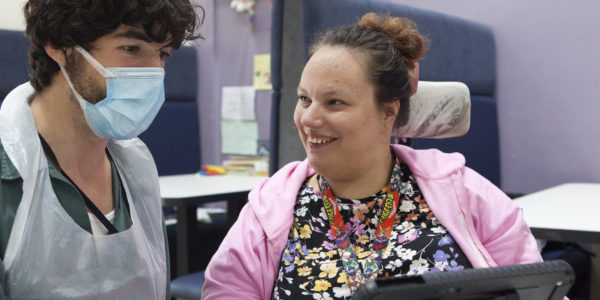Why disabled people must be at the heart of accessible tech design
Google, in consultation with disabled people, has opened a new Accessibility Discovery Centre in London.
Recently, Sense was invited to pay a visit, so I went along to check it out. I’m a massive advocate for accessible technology, so I was living my best life that day!

The Accessibility Discovery Centre is a space where engineers, researchers, product teams and partners can build new kinds of accessible technologies to remove more of the barriers that disabled people face every day.
The visit got me thinking about the important role technology has played in my own life.
Whether it’s my screen reader which enables me to read and write this blog, or my cochlear implants that have made such a difference to my hearing.
When we talk about accessible technology we aren’t always talking about apps, websites or complicated electronics. Sometimes a solution can be really simple but hugely transformative.
“If you’re designing something for disabled people, you need to get our input into the process. It’s morally the right thing to do.”
For example, one of the things I saw at the centre was a self-balancing spoon for people with hand tremors.
In order to come up with these simple yet vital solutions, it’s important to involve disabled people in the design and development of technology. Here are three reasons why:
Reason 1: It’s the right thing to do
Firstly, ‘Nothing about us without us’.
In the context of designing technology, this means that if you’re designing something for disabled people, you need to get our input into the process. It’s morally the right thing to do.
By involving disabled people in co-production, you’re also making sure the solution will meet their needs.
Co-production like this also helps to create equality, as disabled people work together with tech developers as equal partners. That’s better than simply imposing solutions on disabled people without our input.

Reason 2: Accessibility must be embedded in the process from the start
Secondly, it’s really important to involve disabled people at the start of a project, rather than trying to bolt accessibility on at the end of the process.
By working with us from the outset, you’ll identify problems and solutions at an early stage.
“When disabled people are at the forefront of the design process, technology has the power to be truly transformative.”
This was one of the things that really struck me about the Accessibility Centre Google has created. Here, you have a purpose-built space where disabled people can come together with engineers and designers, talk through ideas, develop those ideas and then test them to see if they actually work.
Sounds simple when you put it like that doesn’t it?
Reason three: We’re the experts

We know what works for us, and, possibly more importantly, what doesn’t work for us.
For example, Sense recently upgraded its website. There are processes that web designers can follow, like the Web Content Accessibility Guidelines (WCAG), to make websites are accessible. This is a great start – but you can’t beat the expertise of disabled people themselves.
At Sense, we wanted to make sure our site was as accessible as it could be, so a number of people with different disabilities (including myself) tested a version of the site as it was being developed.
The developers found it really useful to get our feedback, and to actually hear how a screen-reader interacted with their site. So, while following guidelines is great, you can’t beat the input of the people who will actually be using your product.
When disabled people are at the forefront of the design process, technology has the power to be truly transformative.


